Just as Prometheus gifted fire to humanity, we're here to share another culinary game-changer: sous vide egg bites. We've watched this French-inspired breakfast sensation evolve from professional kitchens to becoming a morning staple in homes across America. If you've tried the famous coffee chain's version, you'll understand why these silky, protein-rich morsels have captured the attention of both food enthusiasts and busy professionals. But what you might not know is that creating these velvety egg bites at home isn't just possible—it's surprisingly straightforward. Let's explore how we can master this technique together.
History
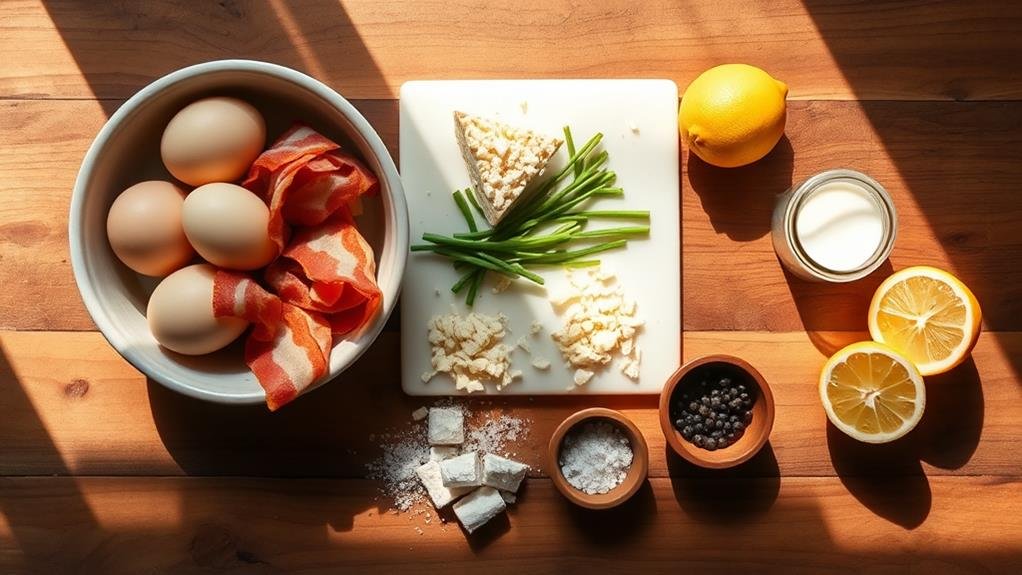
Sous vide egg bites burst onto the culinary scene in 2017 when Starbucks introduced them as a low-carb breakfast option. While Starbucks popularized them, the technique behind these creamy egg delights dates back to the development of sous vide cooking in the 1970s by French chefs Georges Pralus and Bruno Goussault, who pioneered the method of cooking food in vacuum-sealed bags at precise temperatures.
The vacuum sealing process enhances cooking performance by ensuring even heat distribution, which is essential for achieving the creamy texture of the egg bites. This method not only retains natural flavors but also extends storage life by preventing oxidation and spoilage, making them a practical choice for meal prep and long-term storage enhanced cooking performance.
We can trace the evolution of sous vide eggs even further back to traditional Japanese onsen tamago, eggs cooked slowly in hot spring water. This centuries-old technique produced eggs with a similar silky texture to today's sous vide versions. The modern egg bite concept emerged from professional kitchens looking to create perfectly consistent, protein-rich dishes that could be prepared in advance and reheated without losing quality.
Since their introduction at Starbucks, we've seen sous vide egg bites become a staple in home kitchens, with manufacturers developing specialized equipment and molds specifically for making them. The dish represents a perfect marriage of traditional cooking wisdom and modern precision technology.
Recipe
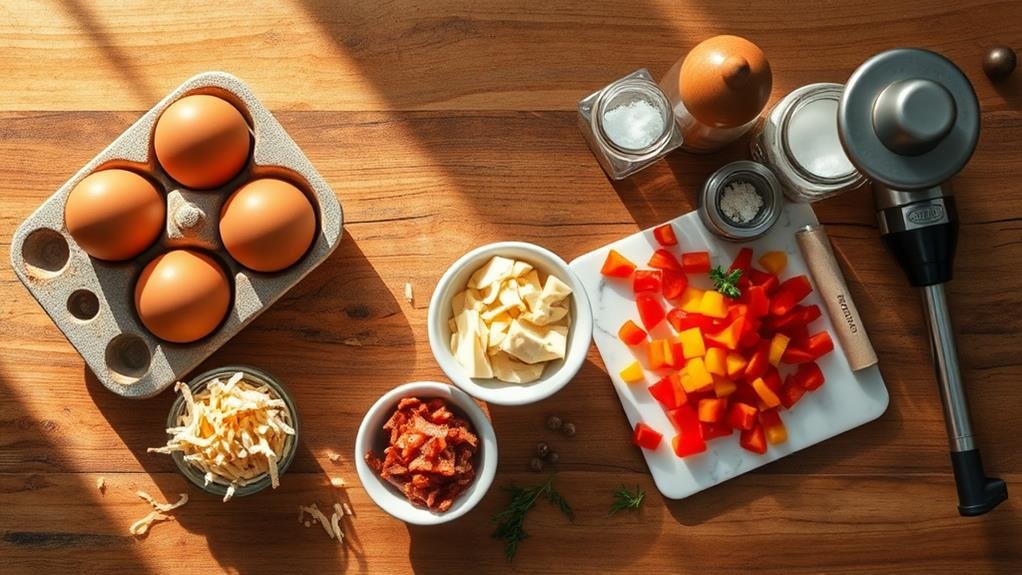
Sous vide egg bites deliver a silky, custard-like texture that's impossible to achieve through traditional cooking methods. These protein-packed breakfast treats have gained popularity for their versatility and convenience, allowing busy professionals to enjoy a gourmet breakfast experience at home or on the go.
The key to perfect sous vide egg bites lies in the precise temperature control and gentle cooking process, which guarantees even cooking throughout while maintaining a luxuriously smooth consistency. While similar to traditional egg dishes, these bites offer a more refined texture and can be customized with countless ingredient combinations to suit any palate.
- 6 large eggs
- 1/2 cup shredded cheese (cheddar or Gruyère)
- 1/4 cup diced cooked bacon
- 1/4 cup diced bell peppers
- Salt and pepper to taste
- Cooking spray or oil for greasing molds
Set your sous vide device to 172°F (78°C) and allow the water bath to come to temperature. Blend the eggs until smooth, then add cheese, bacon, bell peppers, salt, and pepper, blending again until well combined. Spray silicone molds or small glass jars with cooking spray, then fill each cavity with the egg mixture, leaving about 1/4 inch of space at the top. Cover tightly with foil if using silicone molds, or secure lids on jars finger-tight.
Carefully lower into the preheated water bath and cook for 60 minutes, or until the egg bites are set but still tender.
For best results, avoid overfilling the molds as the eggs will expand slightly during cooking. If making ahead, these egg bites can be refrigerated for up to 5 days and reheated in the microwave for 30 seconds. To prevent water from seeping into the egg mixture, verify all containers are properly sealed before submersion. Experiment with different cheese combinations and add-ins, but maintain the basic egg-to-ingredient ratio for consistent results.
Step By Step
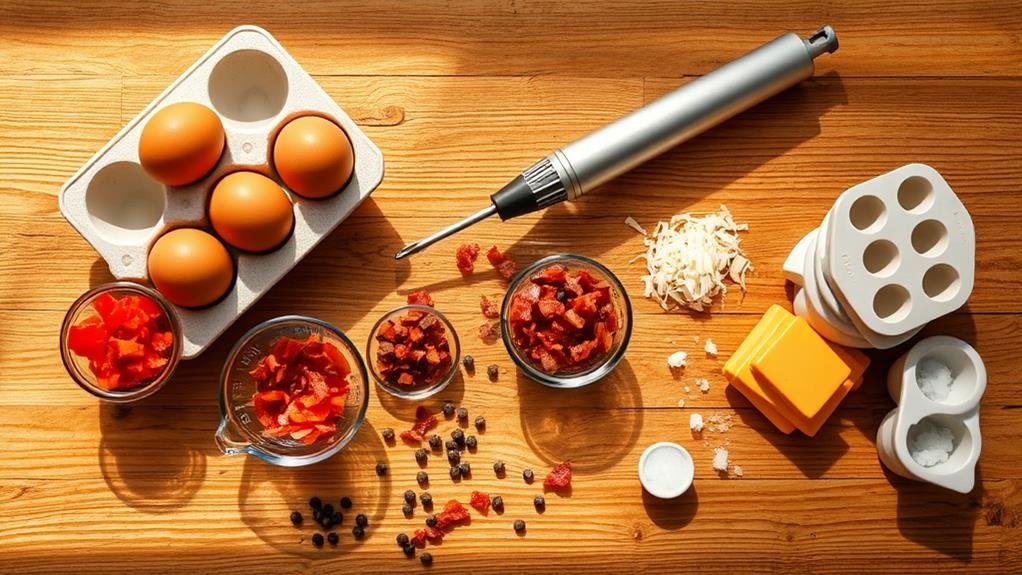
Let's start by preheating our sous vide water bath overnight to reach the ideal temperature of 172°F.
We'll blend our eggs, cheese, bacon, and peppers until they're flawlessly smooth, then carefully pour the mixture into our prepared silicone molds or glass jars.
After cooking the egg bites for 60 minutes in the water bath, we'll let them cool slightly before serving to guarantee they maintain their shape and creamy texture.
Step 1. Preheat Water Bath Overnight
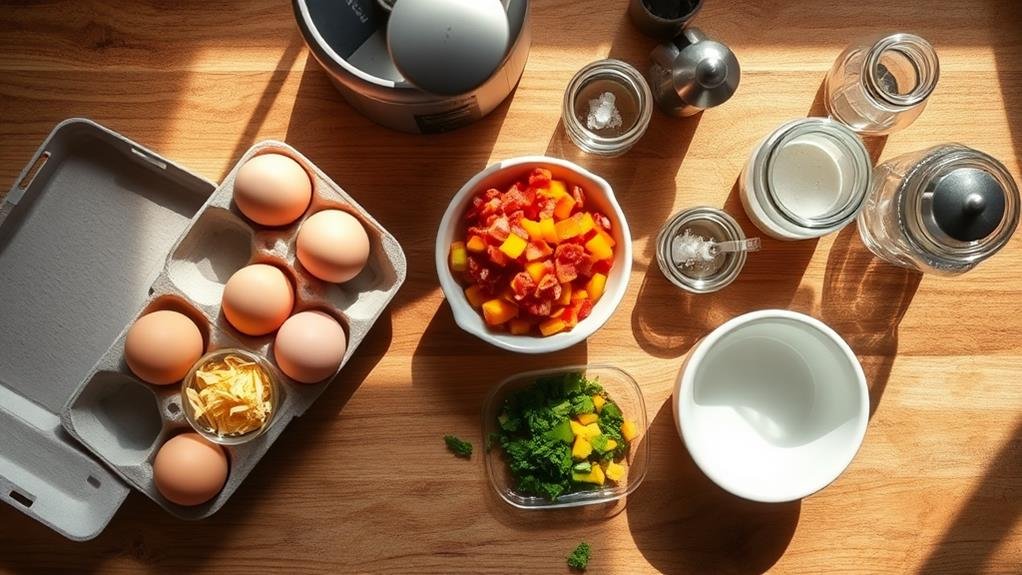
Preparation the night before guarantees your sous vide water bath is ready for morning egg bites. To optimize temperature when we're ready to cook, we'll set up our sous vide circulator in advance.
Let's get the water bath ready by filling our container with warm tap water and positioning the sous vide device securely on the side.
- Set the temperature to 172°F (78°C) before going to bed
- Place a lid or aluminum foil on top to minimize overnight water evaporation
- Position the container away from drafts and off any delicate surfaces
- Check that the water level is between the minimum and maximum fill lines
When we wake up, our water bath will be perfectly heated and stable, saving us precious morning time. The preheated bath means we can immediately start cooking our egg bites without waiting for temperature adjustment. If we notice the water level has dropped overnight, we'll simply top it off with hot tap water to maintain the proper level.
This overnight preparation method not only streamlines our morning routine but also optimizes consistent cooking temperatures from the moment we add our egg bites.
Step 2. Blend Ingredients Until Smooth
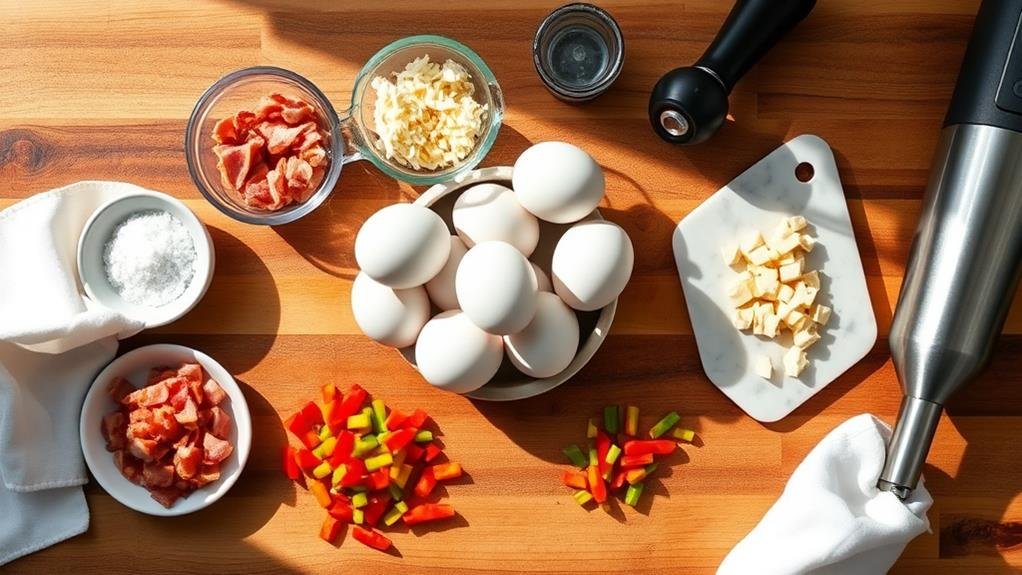
The blending process transforms our simple ingredients into a silky mixture that will become perfectly textured egg bites.
Let's start by cracking all six eggs directly into our blender container, making sure no shell fragments fall in. We'll add 1/2 cup of our chosen shredded cheese, followed by the pre-cooked diced bacon and bell peppers.
Before we begin blending, we'll season the mixture with salt and pepper to taste.
Now, we'll start our blender on low speed for about 15 seconds to break down the ingredients, then increase to medium speed for another 30 seconds. We're looking for a smooth, uniform consistency without any visible egg streaks or cheese clumps.
If we notice any ingredients sticking to the sides of the blender, we'll stop and scrape them down with a rubber spatula. Then we'll blend for an additional 10-15 seconds to make sure everything's fully incorporated.
The final mixture should be pourable and have a slightly frothy appearance. We'll know it's ready when there are no visible chunks of cheese or vegetables remaining, and the texture is completely smooth.
Step 3. Pour Mixture Into Molds
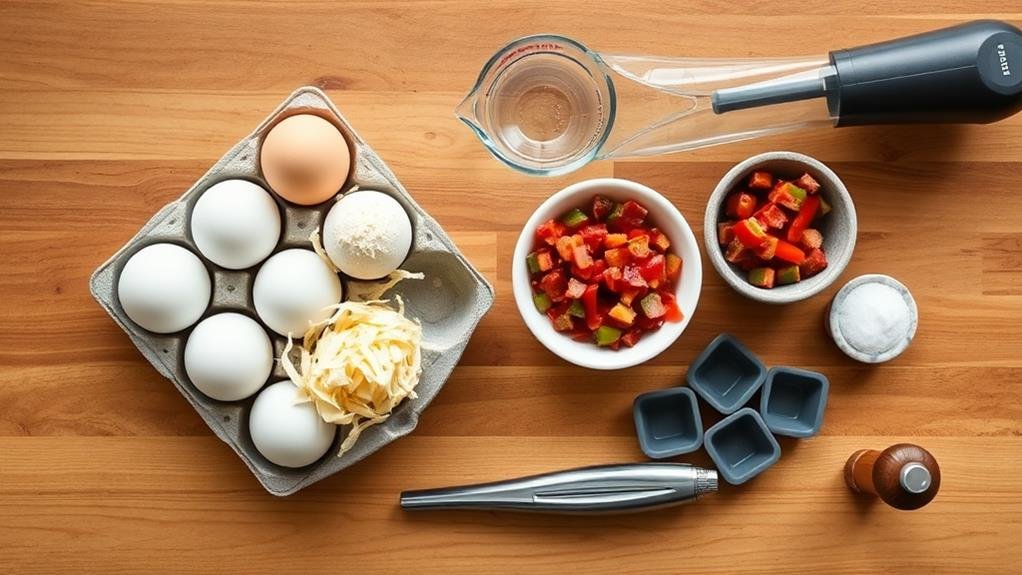
With our egg mixture thoroughly mixed, we're ready to fill our molds for cooking. Let's carefully pour the mixture into our silicone molds or glass jars, leaving about 1/4 inch of space at the top to allow for expansion during cooking. We'll want to tap each mold gently on the counter a few times to release any air bubbles that might be trapped in the mixture.
For best outcomes when filling our molds, we'll follow these key steps:
- Spray the molds lightly with cooking spray to ensure easy removal after cooking
- Use a ladle or spouted measuring cup for precise, mess-free pouring
- Fill each cavity to about 3/4 full to prevent overflow during cooking
- Wipe any spills from the rim of the molds to ensure proper sealing
After filling the molds, we'll cover them tightly with aluminum foil, pressing it firmly against the edges to create a water-tight seal.
If we're using glass jars, we'll screw on the lids until they're finger-tight - not too loose, but not overly tight, as this could cause the jars to crack during cooking.
Step 4. Cook for 60 Minutes
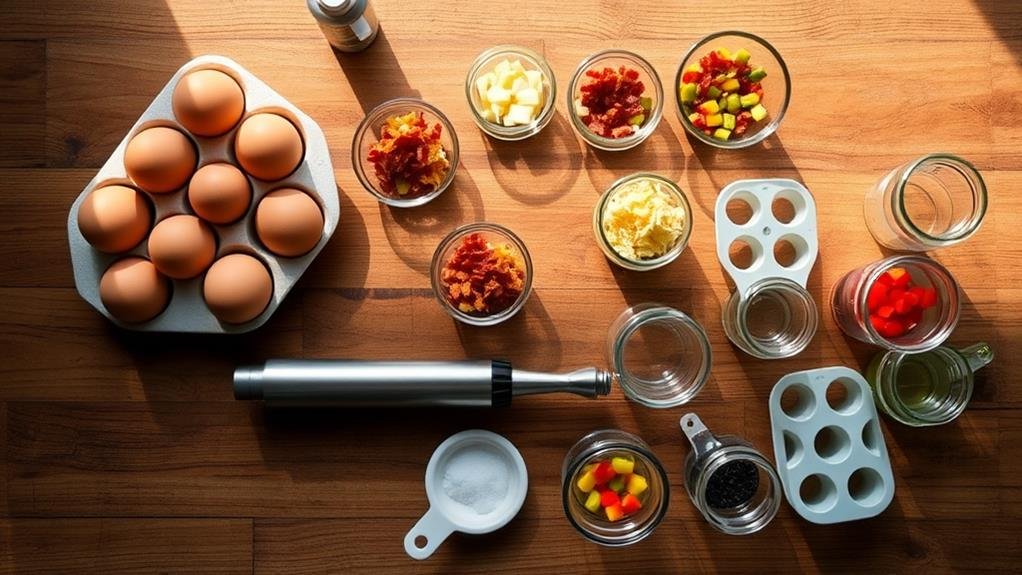
Cooking our egg bites requires precise timing and temperature control for best results. Once we've carefully placed our sealed molds or jars in the preheated 172°F (78°C) water bath, we'll set our timer for 60 minutes. During this time, maintaining a consistent water temperature is crucial to achieve that perfect, custard-like texture.
We'll want to make sure our containers remain fully submerged throughout the cooking process, but the water shouldn't be allowed to enter the molds. If we notice any floating, we can place a weighted rack or heat-safe plate on top to keep everything properly submerged. While cooking, we shouldn't need to stir or disturb the egg bites.
At the 60-minute mark, we'll carefully remove the containers from the water bath using tongs or a slotted spoon. The egg bites should appear firmly set but still maintain a slight jiggle in the center. We'll let them rest for about 5 minutes before removing them from their molds. If we're making these ahead, we can transfer the sealed containers directly to an ice bath to stop the cooking process.
Step 5. Let Cool Before Serving
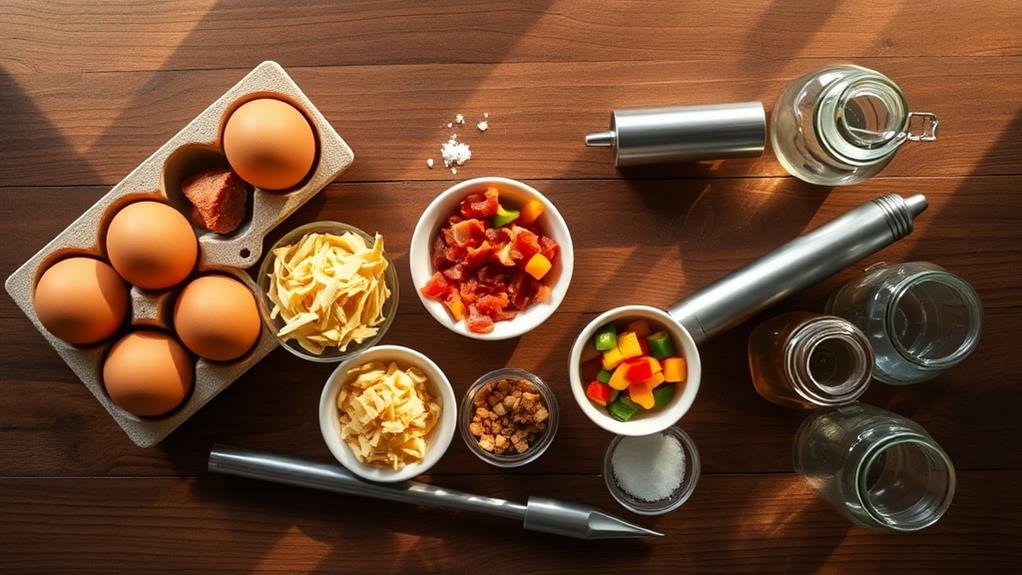
After our 60-minute cooking time, we're ready to begin the important cooling process for our sous vide egg bites. Let's carefully remove the jars or molds from the water bath using tongs, and place them on a wire rack or heat-safe surface. We'll need to let them cool for about 5-10 minutes before attempting to remove them from their containers.
During this cooling period, several important processes are taking place that will guarantee the perfect texture and presentation of our egg bites:
- The proteins are continuing to set, helping the egg bites maintain their shape when unmolded
- The internal temperature is dropping to a safe handling level, preventing any burns
- The eggs are slightly contracting from the sides of the containers, making removal easier
- The texture is developing its final custard-like consistency
Once the egg bites have cooled sufficiently, we can gently run a knife around the edge of each container and carefully invert them onto a plate. If we've used silicone molds, they should pop out easily with a gentle push from the bottom. Our sous vide egg bites are now ready to serve and enjoy.
Conclusion
Like fluffy clouds on a plate, our sous vide egg bites have transformed breakfast into an art form. We've mastered the delicate dance of temperature and time to create these silky-smooth morsels that melt in your mouth like butter. Whether you're racing out the door or savoring a lazy Sunday morning, these protein-packed pillows of perfection won't disappoint. They're a game-changer that'll revolutionize your morning routine.
